#lecturesummary
Explore tagged Tumblr posts
Text
Week 6: Semiotics and Visual Literacy
Lecture Summary:
Compared to last week, this week’s lecture contains more information that I was very unfamiliar with and had to constantly refer back to the presentation to understand better. A lot of terminologies used this week was very much new to me, and following the tutorial was a bit of a struggle as well. To make this summary post short, I will be breaking down each section of the presentation into small chunks of information that was discussed during the lecture.
Visual Language
This week, we covered semiotics and visual literacy, an introduction to ways of seeing. We started by discussing visual language.
“Visual language share characteristics with verbal language - both are communicative and structural. Images, like words, are both encoded with meaning.”
Language and communication structure are composed of three things;
1. meaning (semantics) 2. Word order (syntax) 3. Interpretation based on context (pragmatics)
To sum it up, language structures are incredibly important as it involves giving context and meaning/intention to a visual image when placed in a setting - otherwise referred to as an image code. A notable takeaway in this presentation are understanding the importance of context;
“Context dependable; Images are culturally situated (context) and consequently convey different meanings to different viewers based on personal life experiences, knowledge and perspectives. An image is not as concise as texts, they communicate differently as it is super arbitrary compared to texts. Images represent meaning, and they lack syntactical structure of spoken and written language.”
Semiotics
To understand the structure behind visual images better, the presentation then shifted its focus onto semiotics. “Semiotics is an investigation into how meaning is created and how meaning is communicated. Its origins lie in the study of how signs and symbols (visual and linguistic) create meaning.” This is comprised of visual semiotics (Study of symbolic processes) and semiotic analysis (The study of signs and symbols, what they mean and how they are used.)
We then moved onto the discussion of semiotic theories. “The sign; in semiotic theory, a sign is anything that stands for something else - that is, a sign stands for an object or concept.”
An important takeaway in this part of the presentation, is the introduction to Ferdinand de Saussure’s - Also known as the father of semiology, who proposed that the sign in language is the signifier (Sr) and the signified (Sd) as well as Charles Sanders Peirce.


“Peirce’s sign typology emphasises the different ways in which the sign refers to its object - the icon by a quality of its own, the index by a real connection to its object, and the symbol by a habit or rule for its interpretant.”
Icon; The signifier is perceived as resembling or imitating the signified. Index; The signifier is directly connected in some way to the signified. Symbol; A mode in which the signifier does not resemble the signified.
Connotation and Denotation
Continuing on, we then looked at Roland Barthes’ extended concept of signified and signifier - the concept of connotation and denotation.
Connotation; refers to the wide array of positive and negative associations that most words naturally cary with them. (The feeling a word evokes) Denotation; the direct, specific, or literal meaning we get from a sign, a description or representation of the signified, a word that might be found in a dictionary. (what the word literally means)

To add on this, we begun discussing Syntagmatic and Paradigmatic.


Lastly, to conclude this part of the presentation, we went over the concept of signification. “Signification; the process of creating meaning is that of locating or identifying the signified, that is, the concept, based on the cues given by the signifier, the sign. In philosophy, the encoding is a process of “reading” sense data, a set of natural signs that represent “true conditions””
In the latter part of this lecture, we reviewed various ‘clever graphic advertisements’ and how each design are manipulated (as the theories suggests) that communicates a visual language. These examples demonstrated all analysis that has been discussed today.




(05.04.2022)
9 notes
·
View notes
Text
Week 5: Adobe Illustrator - Layers Importing, Adobe Acrobat, Saving, Printing
Lecture Summary:
As we are nearing the formative submission, this lesson is mostly dedicated to covering/briefing the class on what is required for submission. The latter part of the presentation is then dedicated to answering students’ questions and guiding us regarding our current progress. Most of this lesson is mainly given to us to spend working on our timeline design.
Lab Teaching:
We are also given another brief tutorial on using illustrator. In this tutorial we looked over using colour swatches and manipulating images.
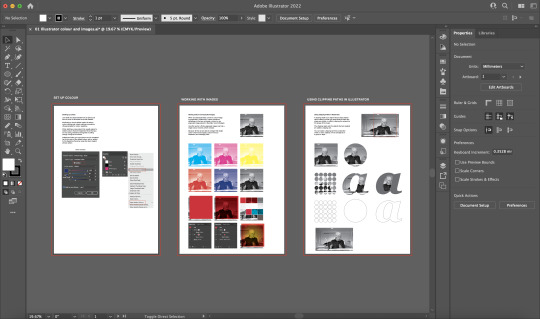
(31.03.2022)
0 notes
Text
Lecture Summary-Construction/Deconstruction Narrative Through Image
In this lecture, the topic was the perception of narrative through image and how we process the information. This lecture to me was very detailed and about a topic I have never really explored deeply before.
Basic perception theory was the main sub topic of this lecture which then leads on to symbolism and visual language. The topic I found most interest was the basic theory perception since I never thought of it in as much detail as we did today.
I learn that vision and visual are consolidated and we do not automatically know how to see and react to seeing. This could be seen with babies as their vision develops and the learn to see by seeing light bounce off objects and reacting by touching the object. The real world is an interpretational construct in the way that we don’t see world as it is, the light bounces off objects to hit our retinas and the brain translates this data into what we see.
Our visual senses operate within specific bandwidth. This means we have a sort of spectrum which our visual senses can operate and outside that we are unable to process. For example, animals could an extended bandwidth and see more than we can.
This lecture was the most complicated so far but the most interesting.
0 notes
Text
Week 4: Adobe Illustrator - Brief and Timeline Discussion
Lecture Summary:
In week 4, we are given more details on the formative submission and what our timeline will revolve around starting from this week. We then moved on to discussing the design process, this is vital for us to review as we will need to follow this process when designing our timeline posters.

In short, the design process follows this pattern; defining the problem, brainstorming, gathering resources, drafting/developing ideas and creating works. To expand on this, we reviewed the designer, Ellen Lupton’s description of a design process. She narrows down these steps into three major categories; Defining the problem - inventing ideas - creating forms. In the presentation, we closely examined what these categories meant, and how we could achieve these steps in our design. For instance, we discussed how we could brainstorm and gather resources by using tools that are provided to us, such as the AUT library.
A few other notable point in the design process was the use of mind mapping, documentation and proofing. Mind mapping, also called radiant thinking, is a form of mental research that allows designers to quickly explore the scope of a given problem. This was an interesting concept as I had not previously touched on this topic before. Mind mapping would be incredibly helpful during this process, as I will be able to organise and categorise information based on its importance. Documentation in this context refer to collecting every bits of work I will, or have produced throughout designing. This will be an important step especially for this paper as we will need to constantly jolt down thought processes, give annotations and context. Lastly, proofing was another interesting step to touch on. Though I am familiar with constantly gaining feedback on design work, it hasn’t really occurred to me that I need to be regularly ‘proofing’ (testing) my design solutions and reviewing parts that needs to be further worked on.
Furthermore, in the latter half of this presentation we started reviewing various examples of iterative design processes. An example that stood out to me in the presentation is;

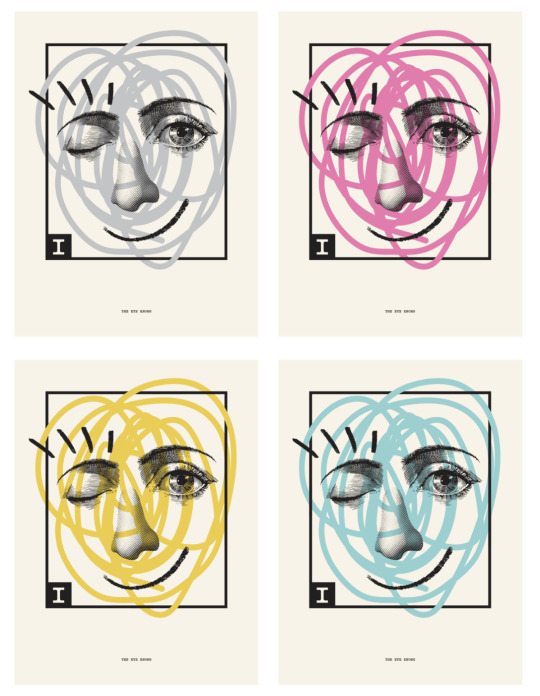
In Lab Teaching:
In this week’s in lab teaching, it is a continuation of our illustrator introduction. We are further introduced to other tools and functions, such as the use of grids in adobe files.

(24.03.2022)
0 notes
Text
Week 3: Adobe Illustrator Interface and Tools
Lecture Summary:
In this week’s lecture, we started off with some feedback regarding the work we have done so far. It is here that I realised my work and research are quite vague and was not enough overall. Following this feedback, I plan to go back to my previous posts and edit my research. I want to include more details in lesson discussions as well as my research on Tibor Kalman. After reviewing what information I had of Kalman, I realised that it wasn’t enough and for me to produce a timeline infographic, I need to understand Tibor Kalman style of work better.
Lab Teaching:
Today’s class mainly focused on lab teaching, where we are given a detailed introduction to illustrator, and various tools used in the programme. First, we are given an overview to the basics of illustrator. Here, Karol explained the contents of vector graphics, file formats, illustrator artboards. Following this introduction, David continued the session by directing the class through a more detailed explanation on how to use the tools while we follow along.
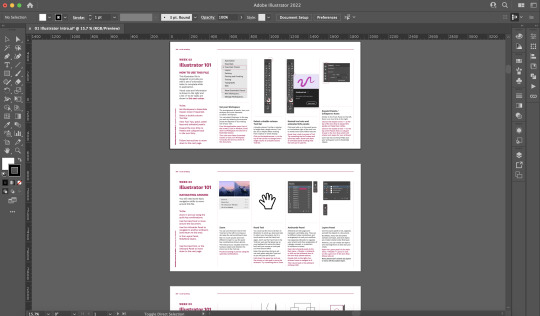
We are given an AI file that acts as an activity sheet where we can review the materials while following David’s explanation.
I really enjoyed this particular lesson, as it was fun to utilise different tools and play around with each functions. This was also extremely helpful for me to build a better understanding on illustrator. Though I have used illustrator before, I realised that there were many functions that I could’ve utilised better for a faster result.
(17.03.2022)
0 notes
Text
Week 5: The Avantgarde
Lecture Summary:
This week, we shifted our focus back to discussing the brief history of western design. Following from our first design history lecture, this presentation included contents from the years 1910 to 1930, where we reviewed contents such as The Avantgarde, Futurism as well as Dadaism.
During 1910 to 1930, there were major events in the world that made a significant impact to the design world. There were massive changes in the technology and science industry with the occurrence of the first world war and the Spanish Flu.
The first part of this lecture focused on reviewing major world events during the time, such as WWI and Albert Einstein’s theory of general relativity.
World War I happened in 1914 and lasted for four years, just around the time of the Spanish Flu’s appearance. The war negatively impacted the lives of many, and provided both chaos and opportunities. Many young soldiers went to war and fought to escape poor living conditions or for other reasons and countless towns were destroyed during this period.
From 1918 through 1920, the Spanish Flu killed from 17.4 to 100 million people worldwide. In comparison, Covid-19 deaths are 6.07 millions. The Spanish Flu was so deadly that bodies piled out in the streets due to the massive death counts.
In 1916, Albert Einstein’s theory of general relativity changed the way we look at the cosmos and how gravity is a bend of space by mass and energy. This theory challenged the way we view the universe and the initial idea of gravity discussed by Isaac Newton further developed into this theory by Albert Einstein. He talked about the fourth dimension, that he described as space and time and this topic during the time was eye opening for the world. People, and especially artists were very stimulated by this idea of seeing reality in a different way. The impact of this theory can be seen through Cubism and Futurism, where artists are incredibly fascinated by this idea of time, movement and illusion.
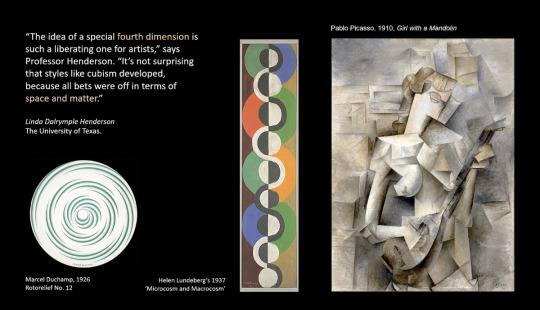
The Avant-garde, started in the 19th century and ended in the 1920s and 1930s. The french term refers to something visionary and ahead of its time. In reference to art, the term means any artist, movement, or artwork that is regarded as innovative and boundaries-pushing, opposed to mainstream cultural values, and with social or political connotations. Avant-garde designers were young people, in their 20’s. They wanted nothing less than to change the world.
The avant-garde artists were surrounded by chaos. (Industrialisation - technology - world war - science) They had guts and vision, embracing mass communication, machinery and challenged conventions.
Many movements emerged from this era are Futurism, Dadaism, De stijl, Constructivism and New typography. Through these, we discussed the Futurism and Dadaism movement. Following from these contents, we begin discussing design movements that impacted the world up until 1940.
Futurism is located in the kingdom of Italy 1909. Italy had a very large debt, very few natural resources, and almost no transportation or industries. This combined along with a high ratio of poverty, illiteracy pushed the people of Italy to migrate. This was the time when Futurism emerged. Futurism was an avant-garde movement that embraced innovation, technology, and transportation - all components of the future they saw after WWI. The futurists’ celebration of war as a means to remake Italy and their support of Italy’s entrance into World War I. The futurists consists of mostly males in their 20s-30’s, and are painters and poets. Futurism embraced chaotic paintings, that portrayed speed, movement and power, all inspired by cubists art. They glorify different aesthetics, of industries, workers and war.
An important figure of the Futurism movement is Filippo Marinetti, one of the founders and supporter of Adolf Hitler. Marinetti, who admired speed, had a car accident outside Milan in 1908 when he veered into a ditch to avoid two cyclists. To him, the crash symbolised how the old must always give ways to the new and propelled Marinetti to put into writing a theory of progress. He wrote series of passive aggressive controversial statements about his vision of the futurist movement.
(Manifesto is a written statement where artists often publicly declare their intentions, opinions and visions about the artistic movement.)
The legacy and the influence of the Futurism can be seen with the way they use materials, breaking conventions and their influences on space and typography. They were very experimental and were very interested in asymmetry designs.
When Marinetti’s political party - a combination of political and futurist views - failed, he tried to promote futurist views in other ways, but it was received in a negative way. This was because a lot of artist decided to move onto other artistic movements, but also of the negative association of futurism and fascism. Artistic groups began forming in Europe and this lead to Dadaism.
During WW1, some artists and writer served bravely, some even died and other went into exile. Dada was composed of artists in exile, in nations that were either safe, like America, or neutral, such as Switzerland and Spain. Dadaism is often described as an Anti art, they protest against traditional beliefs of a pro-war society, cultural and political critique. Dada artists produced art that were funny, satirical, irrational and humorous.
The presentation continued covering contents of other Dada artist such as Marcel Duchamp Hannah Höch, and briefly analysing some of their works. I only highlighted/summarised notes I had taken during this lecture, and am avoiding to put more information in since it will become too confusing for me to refer back to later on. This presentation is very informative and I was once again amazed by the sheer amount of historic significance in one artistic movement. It’s interesting to see how the movement correlates to each other and learning about its impact, both positive and negative.
(29.03.2022)
0 notes
Text
Week 4: Searching Techniques
Lecture Summary:
In our week 4 lecture, we were meant to have a guest speaker who was going to guide us through the AUT library system. Unfortunately, we were not able to greet the speaker and was instead directed to video presentations she had made in advance. This lecture covered various topics in this order;
Helpful information sources > What can you find with Library Search? > Finding an ebook > Library databases > Art & Design Library Guide > Searching effectively > Choosing search keywords > Refining your search > Viewing and managing search results > Contact the Library
Most of the presentation topics are pretty self-explanatory, and are simple to follow. The presentation essentially briefed us on how to find helpful resources that we will need to utilise throughout our next three years in AUT. We were also given helpful tips on how to maximise the library system and extend our research by using the right keywords and phrases.
(22.03.2022)
0 notes
Text
Week 3: Medias and Areas of Design Practice
Lecture Summary:
Unlike our previous lectures, this week’s lecture covered a lot more content. I had trouble keeping up with the various information that was relayed and often found myself referring back to the class recording to categorise and re-write certain information. The contents that are covered this week ranges from;
BC / AD: Pre-history and early type:
Hieroglyphs, Phoenicians, and the Greek alphabet. Chinese movable type.
1450: Gutenberg Press. Scientific revolution. The enlightenment. Nicholas Jenson, Manutius, Francesco Griffo, Dürer. Other printing processes.
1880-1910: Arts and Craft movement: Industrial revolution, Aesthetics and social reform, Philosophy, William Morris
To start, we first went over various designs in history and how it adapted throughout the world, overtime. We are introduced to the pre-history and early type designs, where we are shown various examples of hieroglyphs (Greek for “sacred carvings”, was a character of the ancient Egyptian writing system) which was the main source of communication of the time. I was quite fascinated with this part of the lecture, it was interesting to see how symbols and characters are developed overtime. Even more so, knowing that these very characters are our direct links to the past.
We then discussed design movements over the decades (or design timeline) are we were more examples of a design timeline. These timelines helps use identify certain movements throughout each period of history. Marcos explained that “These movements are correlated to the space where they happen, where they occur. They also correlate to a certain understanding of the world at that time. Such as philosophy and ideas that were very much influenced by the technology at the time.” I thought that this was very helpful in unpacking what design movements are, and how they impacted our world. It is important to note that the Victorian movement was the most prominent and significant throughout history, as its influences reign over our understanding of design - even till today.
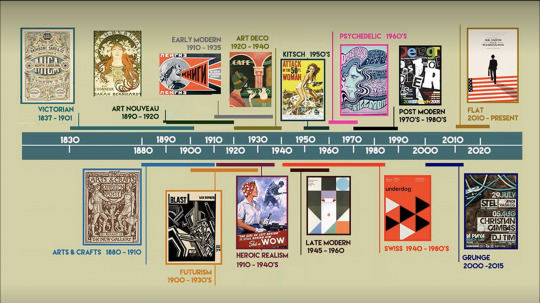
It was mentioned in the lecture that we will need to delve further into design movements as we are to pick a movement and understand the ideas and human philosophies at the time.
Moving on, the lecture then covered more of the history, and gave us a brief overview. A few notable contents includes;
We discussed the dark ages. From the third century until the twelfth century, there was a huge gap in human history referred to the dark age. The dark ages is regarded as lasting from the late 4th to the 10th century in Europe after the fall of the western roman empire, characterising it as marked by economic, intellectual and cultural decline.
Discussed the scientific revolution (Starting with Copernicus’s assertion that the sun was at the centre of the universe, not the earth, a great spiral of scientific discoveries ensued, challenging almost every aspect of the known natural world) and the enlightenment (Due to this new scientific developments and methods of obtaining knowledge, the philosophical movement called the enlightenment arose, in which philosophers of hte time began to question political institutions and society in unprecedented ways.)
We were given a brief overview of key figures of the enlightenment, such as Sir Isaac Newton and Nicholas Copernicus.
The Gutenberg press, Johannes Gutenberg is best known for his invention of movable mechanised type, which played an important role in the development of the renaissance.
Arts and Crafts movement, which emerged during the late victorian period in England was inspired by the strong Anglo-Saxon tradition of craftsmanship and spread internationally from Great Britain and Europe. The core characteristics of the Arts and Crafts movement are a belief in craftsmanship which stresses the inherent beauty of the material, the importance of nature as inspiration, and the value of simplicity, utility, and beauty.
The Industrial Revolution, changed the world and society. It brought the improvement of machinery and transportation, which created more factories. Many new workers had to migrate to cities for work - facing difficulties with pollution, health, disease, poverty and crime.
Tutorial:
After our lecture, we were then split into our usual tutorial groups. For this week’s tutorial, it was much like last week’s where we were sent into seperate breakout rooms and are asked to discuss our research with our peers. I explained the work/research I have done throughout the week, where I focused my current research on Malaysia and it’s history during the years 1957-1962. During this activity, I was given a lot of feedback on how I could improve/futher extend my research. My lecturer, Tatiana was kind enough to provide me with more insights and I was able to narrow down what I could possibly extend my research. These suggestions included looking into;
-What influences was did Britain had in Malaysia, how did that impact the economic, social and cultural standing.
-How was Malaysia’s relationship with Britain and China at that point of history.
-Further extend my research into exploring the culture of Indigenous people in Malaysia.
(15.03.2021)
0 notes
Text
Week 2: Historical and Socio-cultural Influences
Lecture Summary:
Following from last week’s introductory class, we start to delve deeper into the fundamentals of research. As according to the NZQA guide, “Research is an intellectually controlled investigation that leads to advances in knowledge through the discovery of new information of the development of further understanding about existing information, and practice.” With this explanation, it struck me that it is crucial that we, as researchers understands the importance of each investigations and how to properly utilise the technology that we have today to our advantage.
A notable highlight in this week’s lecture is Marcos’ explanation of research. “Research is a form of discovery, an attitude, because I assume I don’t know everything. When we don’t know, we have to be humble and understand there are things I don’t understand. It becomes an experience of knowing.” This explanation was extremely comforting to hear as I had realised from last week that there are many topics I am unfamiliar with. I believed that not knowing/understanding my chosen topic will automatically mean that I will be behind in class. Marcos puts it into words perfectly and I am able to understand that with the right attitude and the right tools, I will be able to provide myself with countless opportunities to learn. Another notable discussion in this lecture is the concept of Tacit knowing (suggested by Micheal Polanyi), which implies that there are knowledge humans can comprehend intuitively, but are unable to properly express it through a comprehensive manner. This concept was interesting as it co-exists with explicit knowledge (Information that are factual and are available) and the theory verbalised how we could utilise the explicit knowledge to bring out our tacit knowledge.
Furthermore, in this lecture we went over various references and examples regarding the current state of our research phase and we move forward from last week’s SDL. It is suggested that we narrow down and choose a 5 year period of a place and look into various medias and trend influences of our selected years. (Such as fashion trends, current political influences and major worldwide event.)
(08.03.2022)
0 notes
Text
Week 2: Overview of Timeline Poster
Lecture Summary:
In this week’s Lecture, the class is split into two parts, class lecture and in lab teaching. In the first part, we explore various types of design and what its influences were depending on the era. We looked over the development of poster designs as well as timeline examples. A few notable takeaways in this lecture was understanding how posters are structured and what purpose it serves.
“Posters tell visual stories, announce events, and bring ideas to life. Posters are a simplification of complex information and ideas. Using visual metaphors and pared down icons help to communicate big ideas while reducing clutter - absence of elements.”
It was interesting to see how posters develop over time, as it was one of the earliest forms of advertisements (Dating back to early 19th century). When we reviewed each posters over the years, it was clear posters had a significant role in our history, communicating various ideas with large amount of audiences when technology was not as advanced as today.
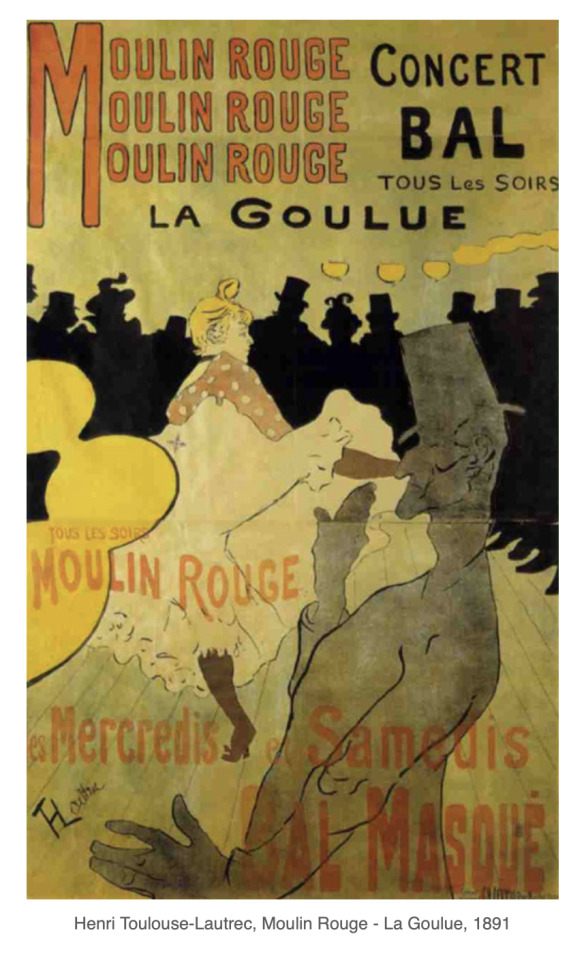

Here, we can see a clear difference in how drastically the designs have changed, from the Art Nouveau era and moving towards the post war era. For me, this part of the lecture was incredibly informative and helpful.
Later in this lecture, we also looked at various timeline (infographic) examples.


“Infographics, a compound word of ‘information’ and ‘graphics’, are design compositions that quickly and clearly represent information, data, or knowledge. Infographics improve understanding by utilizing images, graphics and text to enhance an audiences ability to see patterns and trends and to make connections.”
“Timeline infographics are a type of infographic that offer a way to visualise a process over a period of time. This style of infographic is often used to portray the history of a specific event, a figure or movement. Timelines often have a very linear progression.”
In the second part, we were given the opportunity to explore an adobe programme, or more specifically photoshop. We went over different basics of photoshop and various functions such as filtering, layering and blending. I have little experience with using photoshop, so these tutorials are incredibly helpful, and I now have a better understanding on what I would need to work on.
(10.03.2022)
1 note
·
View note
Text
Week 1: Designer Research (Tibor Kalman)
Lecture Summary:
In our first materials and medias lecture, we are introduced to general information regarding the course contents as well as future assignments. For this paper, we will be randomly assigned a designer, and will be asked to design a visual timeline (formative) for said designer. During this session, we are guided through various programmes we will be using throughout this semester (such as adobe suit and canvas).
Self-Directed Learning (SDL):
For this week, we are instructed to gather and research rudimentary information (date of birth, place of work, etc) regarding our assigned designer. I have compiled my findings as shown below.
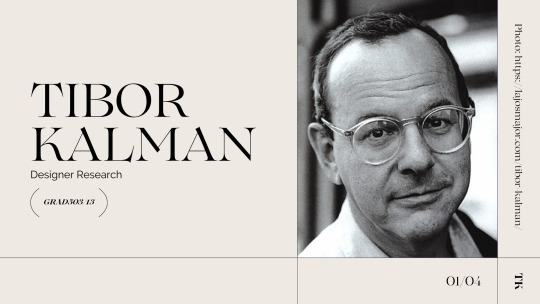
During the lecture, it is explained that we are given starter packs of basic information on our allocated designer that are compiled together. This was extremely helpful as I had a better idea of how I could direct my research and what sorts of materials I would need to research to add more details into the starter information.

To start, I wrote down a very simplified explanation of Tibor Kalman’s background and career using the starter pack information that was given. This helped lay out a foundation knowledge regarding my allocated designer’s background and also provided helpful pointers in how I may want to consider what sorts of information I should be incorporating into the timeline.

Regarding Kalman’s past works, I have put together very few works/projects Kalman was involved in. I plan to further develop this research by looking for more specific information such as an analysis of Kalman’s design elements.
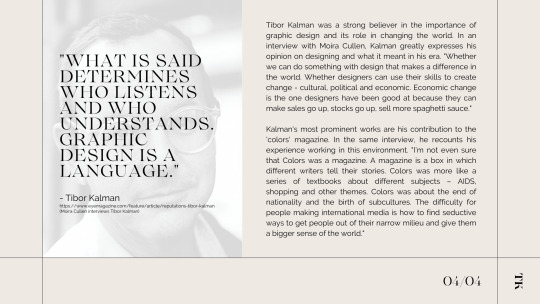
In the given starter pack, there was an interview of Tibor Kalman where he expresses many of his opinions regarding the controversy of his produced works and current concerns and beliefs in the design industry. I thought it would be fitting to include small snippets of his interview as it provided helpful backgrounds in understanding Kalman’s character and his design purposes.
Template taken from: https://www.canva.com/templates/EAExvbSAbiw-nude-warm-neutral-classic-minimal-photography-photography-online-portfolio/
(03.03.2022)
0 notes
Text
Week 1: Welcome
Lecture Summary:
In our first design research lecture, we are introduced to various information regarding the course paper and its contents. Through this presentation, I was able to familiarise myself with my lecturers as well as understanding the brief and assessments that will be assigned to us. A key takeaway of this week’s lecture is understanding that to produce a good research, we will need to think like a detective and always question the intents behind our purpose.
Course Brief:


Following the lecture, we went over the brief for this paper. We are given a basic introduction of what is required of us for this brief, such as the hours we are expected to spend for this paper, and extra materials we would need to refer back to in our own time. We are then instructed to review this brief in our own time. I took some time to look through the brief and highlighting/underlining important keywords and requirements. By doing so, it was easier for me to understand how the work in class and outside of class correlates to the brief.
(01.03.2022)
0 notes
Text
Lecture Summary- The Use of Narrative
In this lecture we looked at the use of narrative in fashion editorials and advertising campaigns.
There are four key principles involved which are
> Knowing your audience
> Where the audience are based- which country?
> Cultures surrounding the audience
> Where the work will be seen for example in public, magazines etc.
What I found interesting about this lectures is how heavily influenced by themes such as historical events, the bible, surrealist movement, fantasy and contemporary culture. The D&G campaigns were very similar to the theme they were re creating and led me to ask if this should be allowed. Should photographer create a scene where for example a painting is re create for the benefit of selling a product.
I like the appropriation of this by idealising the theme, re contextualising it then turning it to a commercial piece. This can be seen as taking inspiration from the theme and changing the story to suit the purpose of the commercial piece. I think people are able to recognise or make correlations between historic pieces to the commercial shoots. With the specific audience I think they cater the piece to a recognisable theme so the audience understand and they can get the results from making the commercial shoot.
In some cases the piece may not be appropriate for the audience and may cause some offense for example featuring offensive objects such as knives or be produced around a politically intense time for example crime and the audience may think the campaign is insensitive to these subjects.
0 notes
Text
Lecture Summary- Autobiography and Biography
Autobiography is an account of a person’s life written by themselves.
Biography is detailed description of a person’s life. A biography can include basic facts and further information such as education, careers and relationships. It is a portrayal of a person’s experience of these life events.
I think the most common form of someone documenting their lives are diaries but with social media they could be seen as a type of biography where people documenting their lives for example uploading photos about their days on their snapchat story.
Diaries could be out of date these days. maybe some of the younger children still do it or even the older generation who started years ago. But I think these days social media especially photo based ones like snapchat and Instagram can be seen as a form of biography.
Artist can be seen as auto biographers since they’re documenting themselves through self portraits. They are showcasing how the look, giving a visual description of how their lives are. I think these are popular among painters to start with such as Van Gogh and now it has become popular in all mediums of art such as illustration with comic like features, intimate photography and animations.
What I took from this lecture was how far autobiography and biography have come along, with the development of new mediums of art such as photography to social media to post 10 second autobiography on snapchat.
0 notes
Text
Lecture Summary-Typologies and Archetypes
Typologies is the classification according to general type, especially in archaeology, psychology, or the social sciences.
Archetypes is the original pattern or model from which all things of the same kind are copied or on which they are based; a model or first form; prototype.
I found typologies to be the most interesting aspect of the lecture.
In photography typology is the interpretation of types of things. The camera is used to classify types of subjects, for example architecture, people and still life. Then the photographer gathers all of this in one place such as a book so viewers are able to see it and assess it for themselves.
What I first think of for typology in photography I think of mugshots and how the classification of criminals in order to bring someone to prosecution. I think this type of photography is beneficial in the sense that it can be used more than just a piece of photography to show in an exhibition, but can help with important issues such as crime.
Also it makes me think about medical photography such as post-mortems and how the classification and collection of photograph of for example of an arm could help with comparison of skin, condition and quality. An example was in the presentation of a classification of ears.
0 notes
Text
Lecture Summary- The Portrait
The topic of this lecture was portraits talking about the function of the portrait, the photographer and sitter, the constructed portrait, and constructed self portrait.
The theme I found most interesting in this lecture was the photographer and the sitter. This theme made me think about who’s in control when a portrait photograph is taken. In cases like fashion shoots, advertising shoots for perfumes for example I would imagine the photographer would be in control, telling the sitter how to look, how to pose. This then could mean that the photographer is creating the story, since they are in control.
Flipping it the other way could create a completely different story. if the sitter is in control this could be seen as the sitter wants to be portrayed in a certain way. The sitter might give a false impression to the viewer. An example of this could be the sitter wants to give an impression that they’re powerful or strong by the way they’re posing.
Portraits can be representations of important figure such as political figures, and again the sitter could be in charge giving the viewer a false hope of an important figure.
This lecture made me think about what is portrayed in portraits and who is behind that portrayal. If it is all false hope or the truth about the sitter. If the portrayal of the sitter is seen as false what impression does this leave on the photographer? Is the photographer seen as a risk taker, a liar or genuine career photographer?
0 notes